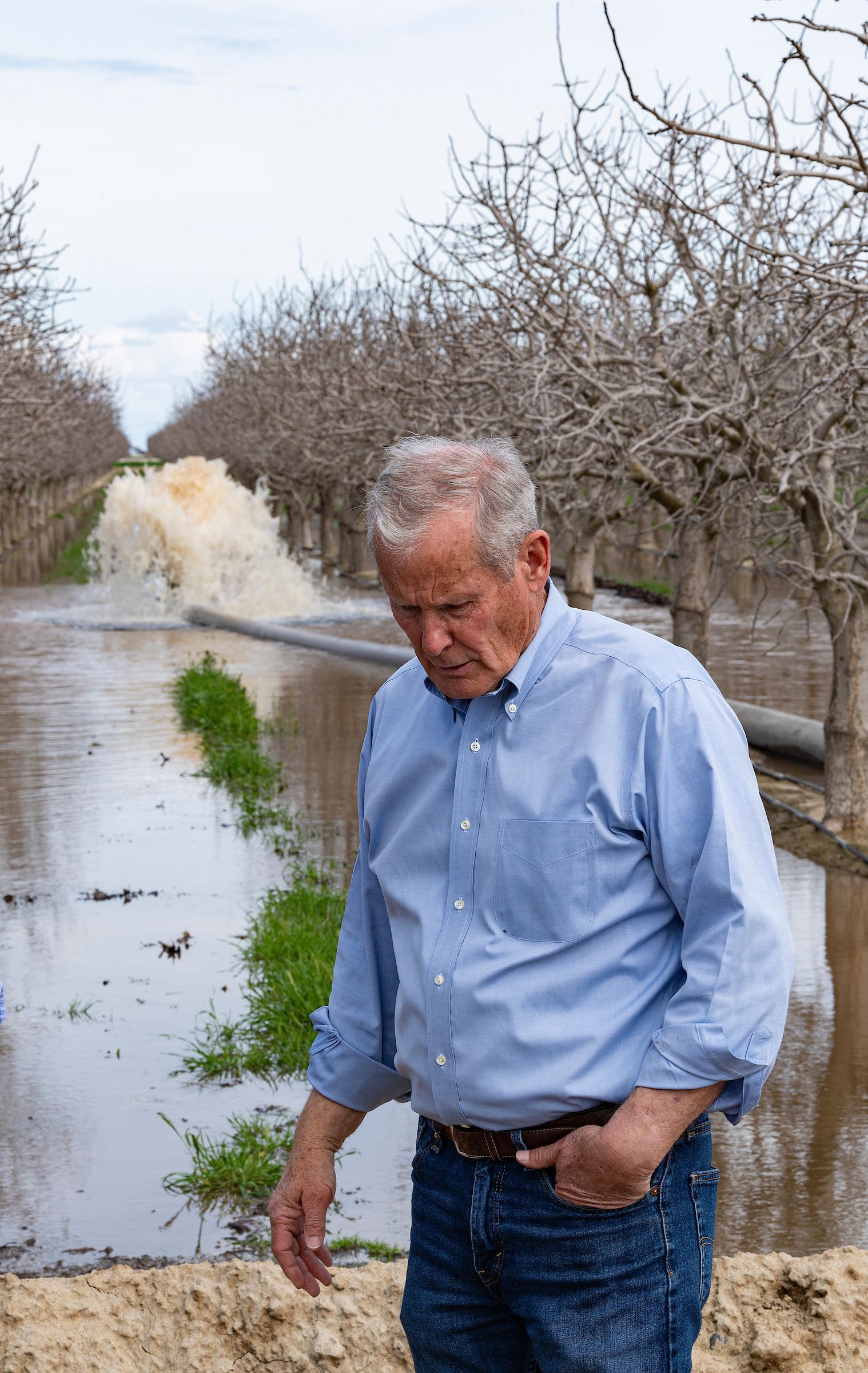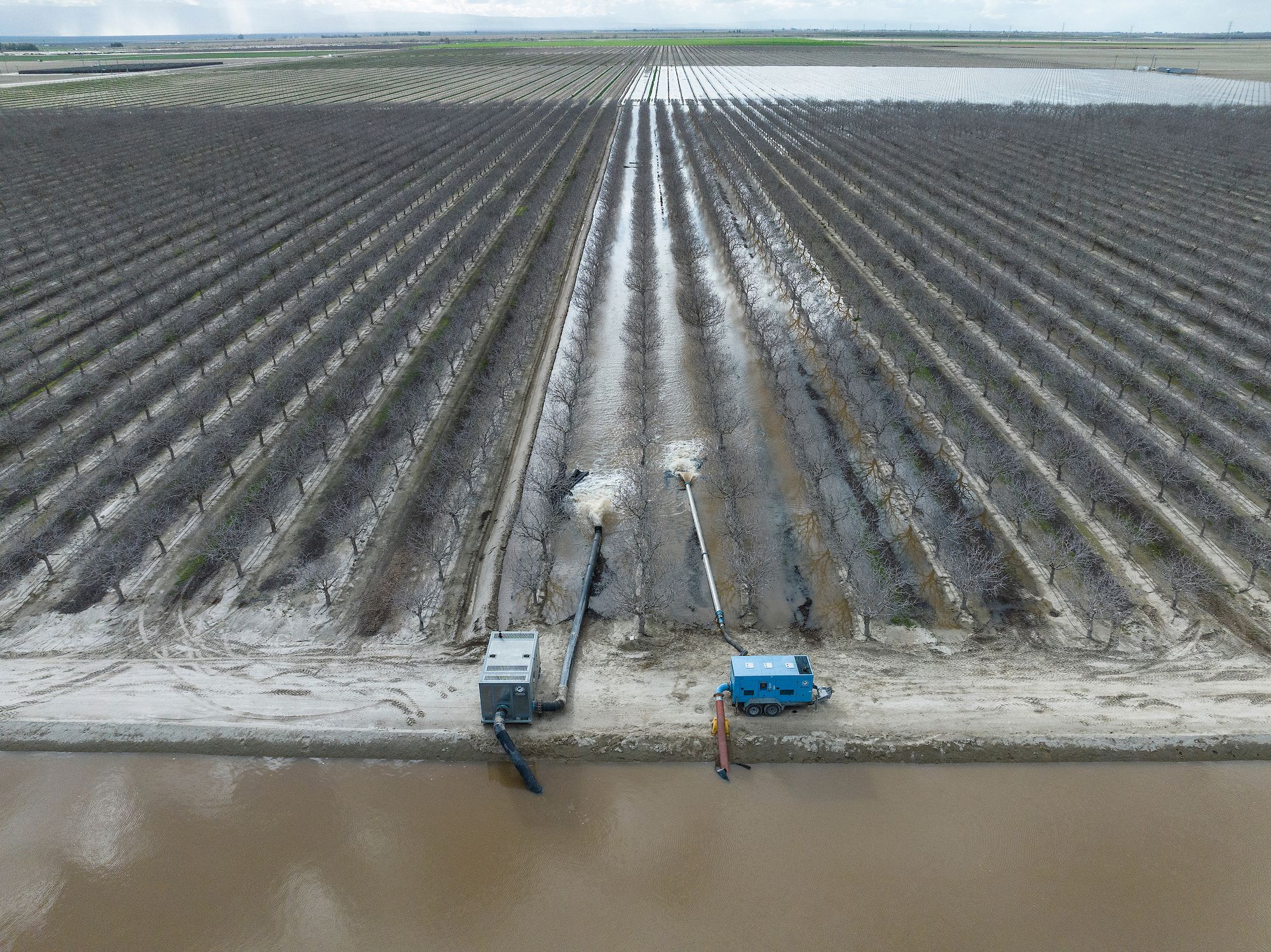Early spring, along the Kings river, during and before the flood

When I arrive at Terranova Ranch in early April 2023, Don Cameron’s dog Lily greets me at the front door of the ranch office barking. When I see Cameron I can understand why Lily is so protective. His shoulders are slumped, his brow hung lower than usual, his face slightly sunburnt. “Hi,” he sighs. “Come on in.”
The last time I visited Terranova was the hot fall of 2021, when the river bottom was bare sand and sagebrush and Cameron sent me home with bell peppers that bore scorch marks from the unceasing summer sun. Things are very, very different now.
The Kings river isn’t just running alongside the ranch, its water is nearly bank to bank, and this is just the beginning. Every day, the Army Corps that oversees water releases from Pine Flat Dam down into the Kings is sending more and more: On this day, 9,835 cubic feet per second, or nearly 20,000 acre feet a day; tomorrow, 9,915; a few weeks from now, 13,320. The “big [snow] melt” in the Sierra has yet to really start in earnest, but the Kings is already officially more than maxed out, running above capacity; channels have been dug out to allow more to flow without running over. About two thirds of that water is running up this route, while the rest runs south, to the reformed Tulare Lake, through gates that the Army Corps has locked op with heavy chains to prevent anyone from stopping it.

The paradigm-shifting model groundwater recharge system Cameron built that I had come to see back in 2021 is now up and running, but it’s taken some doing. The system had sat idle for years, machines and infrastructure all just waiting for this moment. While the sheer, epic quantity of floodwater is its own kind of victory for Cameron, emphatic proof that his project is needed, it’s been far more than he bargained for. "We’ve gone from zero to 100. It would've been nice to have a little bit of a slower start."
When they first fired up the prized 450 horsepower electric superpump on February 27, the engine wouldn’t turn over; technicians had to hard restart the software and run new wiring. Once they were able to begin pulling water out of the river a few days later, they discovered just how many gophers and coyotes had burrowed into the channels while they’d sat dry for months–the next few days were spent plugging holes. Then the winds kicked up–the next few days were spent shoring up washed out levees chewed away by tiny white capped waves. They’ve had to turn the pumps on and off in turns as workers rush to hold the system together. On some windy nights, Cameron himself prowls the ditches in the dark. “I haven’t slept very well since we put the water in,” he admits to me with a little smile. “It’s just, oh my god, what’s gonna break tonight.”
They’ve been spreading the flood across 520 acres of pistachios and 160 acres of grape vineyards, along with fallow fields that would otherwise be planted with tomatoes and other vegetables; as other row crops come out, more of the flood will go on. In the first two weeks they took 4,000 acre feet, more water than they did in all of 2011 or 2017, the only years since Terranova’s recharge project began that the Kings river has provided any water to take. Now they’re roping their neighbors in–bring your own pump, just pay for the power it takes to lift the water out of the canal and over the grade to their land. Cameron hopes they’ll be able to scoop 25,000 acre feet by summer. “I wish we had phase 2 done,” he laments–with region-wide scale they could take ten times as much water. “We’ve turned into a small irrigation district.”

That there is water in the recharge channels and fields of Terranova right now is evidence of how extraordinary this flooding is in nature and in persuasive power. The Kings River’s “fully appropriated stream” status is still officially contested by three competing parties: the Kings River Water Association and its member units that hold the licenses to the river water and whats held at Pine Flat Dam; Semitropic Water Storage District, which if it were given license to any water would owe priority supplies to Sandridge Partners, led by John Vidovich; and the McMullin Groundwater Sustainability Agency, the only district in the river’s watershed that is excluded from its codified service area, including Terranova ranch. It’s been nearly two years since hearings were held on the first portion of the case; no one knows when a decision may come. Much of those hearings focused on how unlikely a flood of this magnitude would be on the river. Semitropic and McMullin argue that no matter how infrequent these floods may come, they do indeed still come–water that only exists every few decades, maybe, is still real water. The rights holders contend that such events are so unusual as to be considered statistical outliers, irrelevant for licensing purposes (though they also then made their own claim to the extra water). By existing license, their floodwater is sent through the southern Kings river outlets into water storage cells on the south end of what was once (and is now again today) Tulare lake. Mark Unruh, a manager for the JG Boswell Company that owns much of the lake bottom clay, testified that water was stored in 2006, 2011, 2017 and 2019, but hadn’t reached farmland since 1998.
I don’t know if the State Water Control Board could or would take this wet year into consideration, but it certainly doesn’t help the general believability of an argument that there is no extra water for anyone. The people who had told Don Cameron that he’d never see a drop in his project are now calling and texting him asking when he’ll have the levees fixed and the pumps up and running again; he can’t take the water fast enough for them. But they also want him to sign a new contract for the water, with a new fee agreement and a release of any rights, current or future, to its use. So far he’s declined.
For now, Cameron is taking water under Gov. Newsom’s executive order that called for more flood managed aquifer recharge and essentially suspended environmental review, seemingly in response to reports that the State Water Control Board was slow-walking temporary seasonal recharge permits. The governor’s executive order was a welcome public relations boost, but it’s not clear that it did much for anyone legally. The water that Cameron will take off the Kings won’t belong to him, but to the aquifer. He’s a little conflicted on that, if only because of how much it’s cost him to get it (and he hasn't even seen his first utility bill yet). But right now he’s more concerned about how much more water there is to come. “I worry if we get a warm spell for a while,” Cameron shakes his head. “I think it’s a ticking time bomb up there. It’s dicey.”
We drive across the ranch in his white Range Rover, Joni Mitchell playing very softly in the background. He admires how the pollinator gardens are growing in along the sandy berms–none of these have eroded like the others, putting a fine point on multibenefit green infrastructure. We pass the curve in the Kings river at the edge of the ranch. “Looks a little different now, huh?” he smiles. “This is what it was all based on.”
Cameron worries that his house on the ranch, with its little backyard wetland with the nesting egrets, will flood as the snow melts and the water crests over the river banks. Maybe the office too. But he’s resigned to it, like you might expect from a man who saw this all coming.